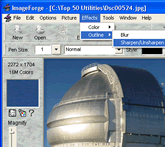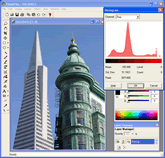| |
| Imageforge
|
Windows' own Paint program falls just a little short on basic functionality, which is where utilities like Imageforge come in. Imageforge opens and saves in a large number of graphics formats, and offers effects to blur, sharpen, posterise, halftone and engrave. There's also the usual sliders to adjust the hue and saturation, brightness and gamma, along with an auto-contrast tool. It's hardly super-advanced stuff, but enough to make your digital camera pictures or scans look punchier. | ||
 |
| Powerstrip
3.20 |
Today's graphics card drivers offer a wealth of options to change and tweak display settings, but none are a patch on Powerstrip 3.20. Powerstrip offers the best part of 500 controls over your display hardware, including colour correction, advanced timings, precision refresh rates and the creation of unusual custom resolutions. Remarkably this single version happily works with the vast majority of graphics chipsets and cards on the market. | ||
 |
| Irfanview
|
Irfanview is a great utility for opening and saving in a vast range of graphics file formats, with a reasonable amount of manipulation features to boot. Effects include blur, emboss, oil paint, edge detection, explosion and pixelise, while the enhance colours option allows you to adjust red, green and blue levels, along with brightness and contrast. Sharpening and resolution adjustments are included too. | ||
 |
| Serif's Photoplus is a considerably more sophisticated offering. The latest version 8 is a full commercial product, but Serif offers the earlier version 5 for free. Along with the usual image enhancements, Photoplus offers more advanced selection tools, editable text, and a variety of shapes who's appearance can be adjusted with a number of sliders. When it comes to exporting your images, Photoplus offers the invaluable facility of a preview with an expected file size. Image slicing and maps are also offered for web designers. | |||
 |
| Mosaic
Creator |
You know those giant images which actually consist of a montage of tiny photos? With Mosaic Creator, you can create your own. It's an eight step process which can be as easy or complex as you like. You start by choosing your main image, followed by the selection of tiny images which will make up the montage. Next you specify the size and shape of the each cell, along with any further enhancements such as blurring and masking. The trial version is restricted by limited file sizes. | ||
 |